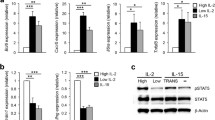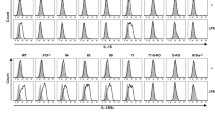Abstract
Despite evidence that interleukin (IL)-1 promotes the proliferation of some T helper 2 (Th2) cell clones in vitro, the physiological role of IL-1 in the regulation of antigen-specific immune responses remains undefined. Using a liposome-DNA delivery system, we transiently expressed IL-1 receptor antagonist (IL-1Ra) to suppress IL-1 functions at the site of the antigen-specific primary immune response. Our data indicate, for the first time, that IL-1Ra downregulates antigen-specific IL-4 and IgE responses, with concomitant enhancement of interferon-γ and IgG2a responses in vivo. In addition, IL-1 can promote Th2 development in an IL-4-independent manner in vitro. Thus, the balance between endogenous IL-1 and IL-1Ra during the primary immune response can be an important factor in determining the antigen-specific effector function of T cells.
Similar content being viewed by others
References
Abbas AK, Murphy KM, Sher A. Functional diversity of helper T lymphocytes. Nature 383:787–793;1996.
Abehsira-Amar O, Gibert M, Joliy M, Theze J, Jankovic DL. IL-4 plays a dominant role in the differential development of Th0 into Th1 and Th2 cells. J Immunol 148:3820–3829;1992.
Andersson J, Bjork L, Dinarello CA, Towbin H, Andersson U. Lipopolysaccharide induces human interleukin-1 receptor antagonist and interleukin-1 production in the same cell. Eur J Immunol 22:2617–2623;1992.
Aoki I, Tanaka S, Ishii N, Minami M, Klinman DM. Contribution of interleukin-3 to antigen-induced Th2 cytokine production. Eur J Immunol 26:1388–1393;1996.
Arend WP. Interleukin-1 receptor antagonist. Adv Immunol 54:167–227;1993.
Arend WP, Malyak M, Guthridge CJ, Gabay C. Interleukin-1 receptor antagonist: Role in biology. Annu Rev Immunol 16:27–55;1998.
Arend WP, Welgus HG, Thompson RC, Eisenberg SP. Biological properties of recombinant human monocyte-derived interleukin 1 receptor antagonist. J Clin Invest 85:1694–1697;1990.
Bochner BS, Rutledge BK, Schleimer RP. Interleukin 1 production by human lung tissue. II. Inhibition by anti-inflammatory steroids. J Immunol 139:2303–2307;1987.
D'Andrea A, Aste-Amezaga M, Valiante NM, Ma X, Kubin M, Trinchieri G. Interleukin 10 (IL-10) inhibits human lymphocyte interferon γ-production by suppressing natural killer cell stimulatory factor/IL-12 synthesis in accessory cells. J Exp Med 178:1041–1048;1993.
D'Andrea A, Rengaraju M, Valiante NM, Chehimi J, Kubin M, Aste M, Chan SH, Kobayashi M, Young D, Nickbarg E, et al. Production of natural killer cell stimulatory factor (interleukin 12) by peripheral blood mononuclear cells. J Exp Med 176:1387–1398;1992.
Dinarello CA. Biologic basis for interleukin-1 in disease. Blood 87:2095–2147;1996.
Doughty LA, Patrene KD, Evans CH, Boggs SS, Robbins PD. Constitutive systemic expression of IL-1Ra or soluble TNF receptor by genetically modified hematopoietic cells suppresses LPS induction of IL-6 and IL-10. Gene Ther 4:252–257;1997.
Faherty DA, Claudy V, Plocinski JM, Kaffka K, Kilian P, Thompson RC, Benjamin WR. Failure of IL-1 receptor antagonist and monoclonal anti-IL-1 receptor antibody to inhibit antigen-specific immune responses in vivo. J Immunol 148:766–771;1992.
Finkelman FD, Holmes J, Katona IM, Urban JF, Beckmann MP, Park LS, Schooley KA, Coffman RL, Mosmann TR, Paul WE. Lymphokine control of in vivo immunoglobulin isotype selection. Annu Rev Immunol 8:303–333;1990.
Fiorentino DF, Zlotnik A, Mosmann TR, Howard M, O'Garra A. IL-10 inhibits cytokine production by activated macrophages. J Immunol 147:3815–3822;1991.
Fitch FW, McKisic MD, Lancki DW, Gajewski TF. Differential regulation of murine T lymphocyte subsets. Annu Rev Immunol 11:29–48;1993.
Gajewski TF, Joyce J, Fitch FW. Antiproliferative effect of IFN-γ in immune regulation. 3. Differential selection of Th1 and Th2 murine helper T lymphocyte clones using recombinant IL-2 and recombinant IFN-γ. J Immunol 143:15–22;1989.
Greenbaum LA, Horowitz JB, Woods A, Pasqualini R, Reich E, Bottomly K. Autocrine growth of CD4+ T cells. Differential effects of IL-1 on helper and inflammatory T cells. J Immunol 140:1555–1560;1988.
Hogan SP, Matthaei KI, Young JN, Koskinen A, Yong IG, Foster PS. A novel T cell-regulated mechanism modulating allergen-induced air-ways hyperreactivity in BALB/c mice independently of IL-4 and IL-5. J Immunol 161:1501–1509;1998.
Hong K, Zheng W, Baker A, Papahadjopoulos D. Stabilization of cationic liposome-plasmid DNA complexes by polyamines and poly(ethylene glycol)-phospholipid conjugates for efficient in vivo gene delivery. FEBS Lett 400:233–237;1997.
Hsieh CS, Macatonia SE, Tripp CS, Wolf SF, O'Garra A, Murphy KM. Development of Th1 CD4+ T cells through IL-12 produced byListeria-induced macrophages. Science 260:547–549;1993.
Jankovic D, Kullberg MC, Noben-Trauth N, Caspar P, Ward JM, Cheever AW, Paul WE, Sher A. Schistosome-infected IL-4 receptor knockout (KO) mice, in contrast to IL-4 KO mice, fail to develop granulomatous pathology while maintaining the same lymphokine expression profile. J Immunol 163:337–342;1999.
Koide S, Steinman RM. Induction of murine interleukin 1: Stimuli and responsive primary cells. Proc Natl Acad Sci USA 84:3802–3806;1987.
Kuchroo VK, Das MP, Brown JA, Ranger AM, Zamvil SS, Sobel RA, Weiner HL, Nabavi N, Glimcher LH. B7-1 and B7-2 costimulatory molecules activate differentially the Th1/Th2 developmental pathways: Application to autoimmune disease therapy. Cell 80:707–718;1995.
Lennard AC. Interleukin-1 receptor antagonist. Crit Rev Immunol 15:77–105;1995.
Lenschow DJ, Ho SC, Sattar H, Rhee L, Gray G, Nabavi N, Herold KC, Bluestone JA. Differential effects of anti-B7-1 and anti-B7-2 monoclonal antibody treatment on the development of diabetes in the nonobese diabetic mouse. J Exp Med 181:1145–1155;1995.
Levine SJ, Benfield T, Shelhamer JH. Corticosteroids induce intracellular interleukin-1 receptor antagonist type I expression by a human airway epithelial cell line. Am J Respir Cell Mol Biol 15:245–251;1996.
Lichtman AH, Chin J, Schmidt JA, Abbas AK. Role of interleukin 1 in the activation of T lymphocytes. Proc Natl Acad Sci USA 85:9699–9703;1988.
Lin JY, Wang LF, Lin RH. The association between lung innate immunity and differential airway antigen-specific immune responses. Int Immunol 8:499–507;1996.
Manetti R, Parronchi P, Giudizi MG, Piccinni MP, Maggi E, Trinchieri G, Romagnani S. Natural killer cell stimulatory factor (interleukin 12 [IL-12]) induces T helper type 1 (Th1)-specific immune responses and inhibits the development of IL-4-producing Th cells. J Exp Med 177:1199–1204;1993.
Mosmann TR, Cherwinski H, Bond MW, Giedlin MA, Coffman RL. Two types of murine helper T cell clone. I. Definition according to profile of lymphokine activities and secreted proteins. J Immunol 136:2348–2357;1986.
Mosmann TR, Sad S. The expanding universe of T-cell subsets: Th1, Th2 and more. Immunol Today 17:138–146;1996.
Ohlsson K, Bjork P, Bergenfeldt M, Hagenman R, Thompson RC. Interleukin-1 receptor antagonist reduces mortality from endotoxin shock. Nature 348:550–552;1990.
Poothullil J, Umemoto L, Dolovich J, Hargreave FE, Day RP. Inhibition by prednisone of late cutaneous allergic responses induced by antiserum to human IgE. J Allergy Clin Immunol 57:164–167;1976.
Renz H, Smith HR, Henson JE, Ray BS, Irvin CG, Gelfand EW. Aerosolized antigen exposure without adjuvant causes increased IgE production and increased airway responsiveness in the mouse. J Allergy Clin Immunol 89:1127–1138;1992.
Rincon M, Anguita J, Nakamura T, Fikrig E, Flavell RA. Interleukin (IL)-6 directs the differentiation of IL-4-producing CD4+ T cells. J Exp Med 185:461–469;1997.
Sabin EA, Kopf MA, Pearce EJ.Schistosoma mansoni egg-induced early IL-4 production is dependent upon IL-5 and eosinophils. J Exp Med 184:1871–1878;1996.
Schmitz J, Thiel A, Kuehn R, Rajewsky K, Mueller W, Assenmacher M, Radbruch A. Induction of interleukin 4 (IL-4) expression in T helper (Th) cells is not dependent on IL-4 from non-Th cells. J Exp Med 179:1349–1353;1994.
Snapper CM, Paul WE. Interferon-γ and B cell stimulatory factor-1 reciprocally regulate Ig isotype production. Science 236:944–947;1987.
Ulich TR, Yin SM, Guo KZ, del Castillo J, Eisenberg SP, Thompson RC. The intratracheal administration of endotoxin and cytokines. III. The interleukin-1 (IL-1) receptor antagonist inhibits endotoxin- and IL-1 induced acute inflammation. Am J Pathol 138:521–524;1991.
Wan GH, Li CS, Guo SP, Rylander R, Lin RH. An airborne mold-derived product, β-1,3-D-glucan, potentiates airway allergic responses. Eur J Immunol 29:2491–2497;1999.
Wang LF, Lin JY, Hsieh KH, Lin RH. Epicutaneous exposure of protein antigen induces a predominant Th2-like response with high IgE production in mice. J Immunol 156:4077–4082;1996.
Weaver CT, Hawrylowicz CM, Unanue ER. T helper cell subsets require the expression of distinct costimulatory signals by antigen-presenting cells. Proc Natl Acad Sci USA 85:8181–8185;1988.
Author information
Authors and Affiliations
Rights and permissions
About this article
Cite this article
Lin, KW., Chen, SC., Chang, FH. et al. The roles of interleukin-1 and interleukin-1 receptor antagonist in antigen-specific immune responses. J Biomed Sci 9, 26–33 (2002). https://doi.org/10.1007/BF02256575
Received:
Accepted:
Issue Date:
DOI: https://doi.org/10.1007/BF02256575




